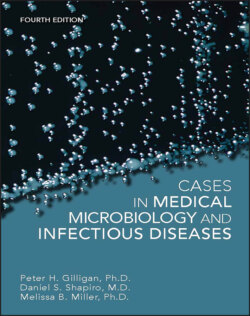Читать книгу Cases in Medical Microbiology and Infectious Diseases - Melissa B. Miller - Страница 14
A PRIMER ON THE LABORATORY DIAGNOSIS OF INFECTIOUS DISEASES
ОглавлениеThe accurate diagnosis of infectious diseases often but not always requires the use of diagnostic tests to establish their cause. The utilization of diagnostic tests in the managed care environment is carefully monitored and is frequently driven by standardized approaches to care called “clinical pathways” or “clinical care algorithms.” These pathways include using a predefined set of diagnostic tests for patients who present with signs and symptoms characteristic of certain clinical conditions, such as community-acquired pneumonia. Currently, the Infectious Diseases Society of America has published more than 30 different “practice guidelines” dealing with various infectious diseases, including HIV, tuberculosis, group A streptococcal pharyngitis, diarrheal disease, and pneumonia, from which clinical pathways can be derived. Clinical pathways and practice guidelines fall under the concept of “evidence-based medicine.” Evidence-based medicine relies on review and interpretation of data in the medical literature as a basis for clinical decision making.
In some patients, such as an otherwise healthy child with a rash typical of varicella (chicken pox), the etiology of the infection can be established with a high degree of certainty by physical examination alone. The use of diagnostic testing in this setting would be viewed as wasteful of the health care dollar. On the other hand, a 4-year-old who presents with enlarged cervical lymph nodes and a sore throat should have a diagnostic test to determine whether he or she has pharyngitis due to group A streptococci. The reason why such testing is necessary is that certain viral syndromes are indistinguishable clinically from group A streptococcal pharyngitis. Because group A streptococcal pharyngitis should be treated with an antibiotic to prevent poststreptococcal sequelae, and viral infections do not respond to antibiotics, determining the cause of the infection in this particular case is central to appropriate patient management. Far too often, antibiotics are given without diagnostic testing in a child with a sore throat. As a result, many children with viral pharyngitis are given antibiotics. This inappropriate use of antibiotics increases antibiotic selective pressure. This can result in greater antimicrobial resistance among organisms in the resident microbiota of the throat, such as Streptococcus pneumoniae. In addition, patients may develop antibiotic-associated complications, such as mild to severe allergic reactions or gastrointestinal distress including diarrhea. One of the goals of the fourth edition of this text is to help you think in a cost-effective way about how best to use laboratory resources. As an introduction to this edition, we will present a general overview of the various laboratory approaches that are used in the diagnosis and management of infectious diseases.
